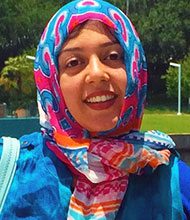
Education
- Postdoctoral Fellow, Cancer Epigenetics, University of North Dakota, Grand Forks, USA.
- Postdoctoral Fellow, Aflatoxins and hepatocarcinogenesis, Aga Khan University, Pakistan.
- Ph.D. in Health Sciences: Microbiology, Aga Khan University, Pakistan.
- M.Sc. in Basic Microbiology and Virology, University of Karachi, Pakistan.
Awards & Honors
- Principal investigator for the Ph.D. research grant from The Aga Khan University Research Council, 2007-2011. Approved amount: $28,500.
- Travel grant for Wellcome Trust Advanced Course on “Functional Genomics and Systems Biology”, June, 2008, Hinxton, UK
- Travel grant for Poster presentation at 14th American Society for Microbiology General Meeting, Boston USA, May 2014.
Research Interests
Dr. Qureshi plans to establish collaborative research projects in Microbiology and Molecular Biology that will involve participation from undergrads in order to give them a taste of biological research in the lab. One of her ideas is to assess the hazardous impact of the numerous toxins and microbes present in our environment and address ways of prevention to the local society.
Dr. Qureshi has experience in the following areas; Bacterial isolation and culture, Polymerase Chain Reaction (PCR), Real-Time PCR, Methylation Specific PCR, Gene Cloning, Adenoviral expression, Protein expression and purification, Chromatin Immunoprecipitation (ChIP), Western Blot, Dot blot, Gel Electrophoresis, Gelatin Zymography, ELISA, Mammalian Cell Culture, Plasmid Transfections, Immunohistochemistry, Immunocytochemistry, mircoRNA, siRNA Transfections, Primer designing, sequence and data analysis using bioinformatics tools.
Biography
Dr. Qureshi has always had an interest in infectious diseases, the organisms responsible for causing them, and the mechanisms of causation and progression. This led her towards the field of Microbiology where she researched on wide areas of projects ranging from bacteriophages, hepatitis C virus, aflatoxins and cancer epigenetics.
Dr. Qureshi completed her Ph.D. in ‘Health Sciences: Microbiology’ from the Aga Khan University in 2011. Her research focus was on a specific protein called the Alternate Reading Frame Protein of the Hepatitis C virus. She then proceeded to do a Postdoc at Aga Khan University in 2013 on aflatoxins and their role in the increased incidence of liver cancer in Pakistan. Her second postdoc was at the University of North Dakota, USA, from 2014-2016 where she worked on two transcriptional factors, Snail and Slug, and their epigenetic regulation in breast cancer.
Selected Publications
- Qureshi H., Hamid S., Ali S. S., Anwar J., Siddiqui A.A. & Khan N.A. Cytotoxic effects of aflatoxin B1 on human brain microvascular endothelial cells of the blood-brain barrier. (2015) Medical Mycology, 53, 409–416.
- Qureshi H., Ali S. S., Iqbal M., Siddiqui A.A., Khan N.A. & Hamid S. Aflatoxins and Hepatitis B, C Viral Associated Hepatocarcinogenesis. (2014) J Cell Sci Ther 5:179.
- Qureshi H., Hamid S., Ali. S. S., Anwar J., Iqbal M., & Khan N.A. Is Aflatoxin B1 a Biomarker for Pathogenic Potential of Aspergillus flavus? (2014) J Cell Sci Ther 5: 1887.
- Qureshi H., Qazi R., Hamid S. & Qureshi S.A. Identification of immunogenic regions within the alternative reading frame protein of hepatitis C virus (genotype 3). (2011) Eur J Clin Microbiol Infect Dis., Vol.30 (9), 1075-1083
- Enam S.F., Qureshi H. & Qureshi S.A. Sampling bacterial biodiversity from a highly contaminated stream flowing through a densely populated urban area in Karachi. (2011) J Ayub Med Coll Abbottabad, Vol.23 (2), 147-151
- Qureshi S.A., Qureshi H. & Hameed A. Hepatitis C therapy–the future looks bright. (2009) Eur J Clin Microbiol Infect Dis., Vol.28 (12), 1409-1413
- Qureshi, H., Saeed S., Ahmed S. & Rasool S.A. Coliphage HSA as a model for antiviral studies/spectrum by some indigenous bacteriocin like inhibitory substances (BLIS). (2006) Pak. J. Pharm. Sci. Vol.19 (3), 182-185








